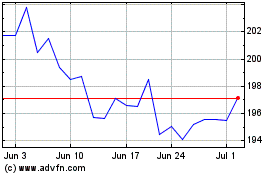By Alexander Osipovich
A few years ago, CME Group Inc.'s main profit engine was stuck
in low gear. Now it is in overdrive.
The futures exchange giant's biggest product line -- U.S.
interest-rate contracts -- is enjoying record trading volumes as
the Federal Reserve accelerates the pace of rate increases.
From 2008 to 2015, the U.S. central bank kept short-term rates
near zero, which limited trading activity in the contracts. Now
with rates rising and inflation awakening, traders are jumping in
and out of interest-rate futures as they speculate on the
probability and timing of rate increases.
That means Chicago-based CME can finally reap the benefits of
the interest-rates empire it built a decade ago. The company merged
in 2007 with its cross-town rival, the Chicago Board of Trade. The
deal gave CME a near-monopoly in U.S. interest-rate futures -- a
position it has held despite attempts by rivals to grab market
share.
"If you want to trade anything in U.S. interest-rate futures,
you're going to be trading on CME," said Christopher Harris, an
analyst at Wells Fargo & Co.
CME's position allows it to raise fees without losing customers,
analysts say. In 2014 the firm pushed through its first big fee
hike in five years, raising transaction fees for Treasury futures
by 9% for its largest customers, alongside fee increases for
energy, metals and other types of contracts. Since then it has
bumped up fees for various interest-rate products each year,
according to CME notices.
The exchange operator also has rankled traders by introducing
new fees for market-data usage. CME Chairman and Chief Executive
Terry Duffy defended the moves on an April 27 phone call with
analysts, saying the firm had long given away data for free and
remained a "low-cost provider" compared with competitors.
Critics worry fees will keep rising. "I don't see anything that
would be a catalyst for fee reductions," said Neal Wolkoff, former
chief executive of ELX Futures LP, a now-dormant exchange that
challenged CME's grip on interest-rate futures. "Usually fee
reductions come in the face of competition, and there just isn't
any."
Adding to CME's dominance, the 2010 Dodd-Frank Act and other
postcrisis rules encouraged trading to migrate from
over-the-counter derivatives to futures, market experts say. In the
OTC market, two companies trade with each other directly, instead
of using an exchange.
Research firm Tabb Group forecasts that 3.8 billion U.S. futures
contracts will change hands in 2017, the fifth straight year of
record volumes. Much of that growth will come from interest-rate
futures, the volume of which is expected to grow 16% this year, a
faster pace of growth than any other type of contract, Tabb
says.
Other CME products -- like energy and stock-market futures --
are better known to the general public. But interest-rate contracts
have been the firm's biggest moneymaker for five of the past six
years, responsible for around a third of the revenue CME collects
in trading and clearing fees.
CME is the world's most valuable exchange group, with a market
capitalization of nearly $40 billion. Its shares closed at $116.83
on Friday, more than double their value from five years ago.
Several challengers have tried to create alternative venues for
U.S. interest-rates futures trading, including NYSE Euronext Inc.,
the former parent company of the New York Stock Exchange, and ELX,
which was backed by a group of Wall Street banks and trading firms.
But those efforts failed to gain traction.
Once a futures contract takes off, it is tough for competing
exchanges to lure traders away from the primary exchange. Market
participants tend to congregate in one place to trade, analysts
say.
The single biggest boost to CME's volumes in 2017 has come from
eurodollar futures. Traders use eurodollars to wager on changing
expectations of short-term interest rates, with activity picking up
on days with Fed announcements or when the Labor Department
releases its monthly jobs report.
From January through May 10, an average of three million
eurodollar futures changed hands daily at CME, up 16% from the
average level last year, the exchange operator says. Eurodollar
futures track the rates paid on three-month dollar deposits outside
the U.S. that earn Libor, a key financial benchmark set in the
London interbank market.
"CME markets certainly benefit when there are increased hedging
and risk management needs by market participants," said Agha Mirza,
CME's global head of interest-rate products.
Eurodollar futures are one of the products that helped transform
an exchange with roots in butter and egg trading into a global
financial powerhouse. Launched in 1981, they supported one of CME's
biggest trading pits, with more than 1,000 traders filling a space
nearly the size of a football field, until the mid-2000s, when the
rise of electronic trading triggered a collapse in open-outcry
volumes.
Krishna Memani, chief investment officer and head of fixed
income at OppenheimerFunds, said his firm recently has stepped up
its use of products like CME's eurodollar futures.
"There's a lot to do on the interest-rate front," Mr. Memani
said. "With the Fed tightening and the Trump trade, there are a lot
of ways you can express a view through interest-rate futures."
Write to Alexander Osipovich at
alexander.osipovich@dowjones.com
(END) Dow Jones Newswires
May 22, 2017 08:16 ET (12:16 GMT)
Copyright (c) 2017 Dow Jones & Company, Inc.
CME (NASDAQ:CME)
Historical Stock Chart
From Mar 2024 to Apr 2024

CME (NASDAQ:CME)
Historical Stock Chart
From Apr 2023 to Apr 2024
